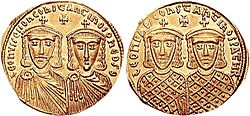Nikephoros (Caesar)
Nikephoros (
Biography
Early life and first conspiracies

Nikephoros was born in the late 750s (c. 756/758) to Emperor
When Constantine V died in 775, his eldest son Leo IV ascended the Byzantine throne. Soon, Leo caused a rift with his half-brothers, when he confiscated a large amount of gold reserved for their use and distributed it to the army and the citizens of
When Leo IV died in October 780, his sole heir was the young
Nikephoros and his brothers disappear from the sources until 792, when the return of Irene to power (after having been ousted in a military revolt in 790), coupled with the disastrous defeat of Constantine VI at Marcellae against the Bulgars, caused widespread discontent among the troops. Some of the imperial guard regiments, the tagmata, proclaimed Nikephoros as emperor, but Constantine reacted swiftly: at the urging of Irene, he arrested his uncles, and while Nikephoros was blinded, the others had their tongues slit. They were then imprisoned at a monastery in Therapia.[4][9]
After 792

Nikephoros is no longer mentioned by name after 792; instead, the brothers are mentioned collectively. It is therefore questionable whether he is to be included in subsequent events, although traditionally (including in reference works like the Oxford Dictionary of Byzantium) it is held that he did share in his brothers' fate and died after 812.[10]
After Empress Irene deposed her son in 797, the brothers were visited at the monastery by some of their supporters and persuaded to seek refuge in the Hagia Sophia. If it had been hoped that Constantinople's populace would be moved to proclaim one of them emperor, their hopes were dashed. No uprising in their support materialized, and Irene's trusted eunuch advisor
The brothers are mentioned for the last time in 812, when a group of disgruntled soldiers tried to proclaim the brothers emperors in the aftermath of the fall of
References
- ^ a b Treadgold 1997, p. 367.
- ^ Rochow 1994, pp. 10–11, 14.
- ^ a b Rochow 1994, p. 13.
- ^ a b c d e f Kazhdan 1991, p. 1476.
- ^ Treadgold 1997, pp. 367, 369; Kaegi 1981, p. 216.
- ^ a b Garland 1999, p. 75.
- ^ Treadgold 1997, p. 417.
- ^ Treadgold 1997, pp. 417–418; Kaegi 1981, p. 217.
- ^ Treadgold 1997, pp. 421–422; Garland 1999, p. 83.
- ^ Rochow 1994, p. 230.
- ^ Treadgold 1997, p. 423; Garland 1999, pp. 86–87.
- ^ Garland 1999, p. 87.
- ^ Treadgold 1997, p. 430.
Sources
- Garland, Lynda (1999). Byzantine Empresses: Women and Power in Byzantium, AD 527–1204. New York, New York and London, United Kingdom: Routledge. ISBN 978-0-415-14688-3.
- ISBN 90-256-0902-3.
- ISBN 978-0-19-504652-6.
- Rochow, Ilse (1994). Kaiser Konstantin V. (741–775). Materialien zu seinem Leben und Nachleben (in German). Frankfurt am Main, Deutschland: Peter Lang. ISBN 3-631-47138-6.
- ISBN 0-8047-2630-2.
